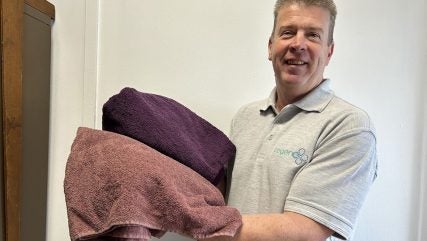
UK
A total of 30 tonnes of hospitality and healthcare textiles have been saved from landfill and rag thanks to new colour treatments from Regenex, the linen revival company. Regenex has over-dyed many thousands of towels, blankets and staff uniforms – saving a huge 90 tonnes of carbon and 150m litres of water associated with the manufacture of replacement stock*.
Most of Regenex’s business involves lifting stains and discolouration from linens to restore its bright, white condition, but the company can also dye items to order at its factory in Bradford, West Yorkshire.
Colour projects for the seven-year-old start-up include:
- Over-dyed continuous roller towels repurposed for manufacturing industry use. The clean but discoloured white rolls were given a new life in a shade of deep blue.
- Hospital blankets and towels dyed to match a healthcare trust and private hospital company’s desired colour schemes.
- Thick and serviceable towels, that could have been condemned due to marks, over-dyed in rich colours for pet use.
- Luxurious white towels over-dyed in a custom shade for a high-end spa facility.
- Towels over-dyed for student use in halls of residence.
- New white hospital scrubs dyed for appropriate rank of medic, during the pandemic, when supplies in preferred colours were difficult to obtain.
Paul Hamilton, technical director at Regenex explained: “We work with some great people in hospitality and healthcare who really think outside the box and want to get the most out of all their resources. It’s great to collaborate and come up with solutions that save both carbon and money.
“The vast majority of our customers are looking for their white linens to be revived to meet the high standards demanded for their use in holiday lets, hospital or care settings. However, dyeing and over-dyeing can be a great option for the right textiles.
“Sometimes we dye tired whites in sumptuous shades, sometimes we simply top up colour that has faded, for example on tough polyester tableware.
“On each of these occasions, serviceable linen was re-purposed into new markets and usage rather than early disposal, due to staining or discolouration.”
*Calculations are based on 5,000 litres of water and 3kg carbon saved per kg processed, on the resources needed to manufacture an equivalent weight of new cotton, assuming that the life cycle of the revived linen is doubled.






